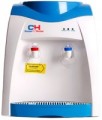Hot water tank volume
The volume of the hot water tank provided in the device.
This parameter describes the maximum amount of hot water that the cooler can produce in one run, without interruption or with minimal interruptions. When this amount is exhausted, you will have to wait until the water in the tank heats up again to a sufficient degree; the waiting time depends on the heating capacity (see below). At the same time, the volume of hot water tanks in modern devices is usually several litres, and it is extremely rare to drain this volume entirely — usually, small portions of 200-300 mL are required. Therefore, this tank plays the role of a buffer — when the user drains the next portion of water, water from a bottle or a water mains is added to the tank; such an admixture does not particularly affect the temperature in the tank, however, for an additional guarantee, the heating system immediately turns on. Thus, if the consumption does not exceed the heating capacity, the temperature of the contents remains practically unchanged.
Heating power
It is the power consumed by the device in water heating mode. Usually, it is the operating power of the heating element.
This parameter is directly related to the heating performance (see above): a high heating rate inevitably requires appropriate power. Also, the power consumption of the device depends on this parameter. However, it is worth noting that after the end of heating, the device switches to the temperature maintenance mode and requires much less energy. In other words, the heater consumes the specified power not constantly but occasionally, as needed.
It is also worth mentioning that in models that work only for heating, this indicator also describes the maximum power consumption of the entire device. And, if there are two modes (heating and cooling), the total maximum power consumption corresponds to the sum of the powers of both modes.
Water supply control
A water supply control method is provided in the device; in other words — the design of the switch is responsible for turning on and stopping the feed.
—
Cup pressure. A system that turns on the water when a glass or other container is brought to the tap. The control body in such systems is usually a special spring-loaded lever that covers the spout on the sides and bottom like a frame. When the user brings the container to the spout, its edge presses this lever, starting the water supply; to stop the feed, it is enough to slightly move the container toward yourself, returning the lever to the neutral position. This method is extremely simple and intuitive, making it easy to use. The disadvantage of such systems can only be called inconvenience when pouring large volumes of water — it can be tiring to keep the frame pressed for a long time. At the same time, in many models, this drawback is eliminated due to the presence of an alternative mode, when the water is turned on by raising the lever towards itself: the lever remains in this position until the user manually lowers it, which eliminates the need to keep the container tightly pressed .
—
Buttons. Water supply control by buttons or keys on the device body. Such controls may have a different design and method of operation: for example, in some models, water flows as long as the button remains pressed; in others, it can be fixed in
...for continuious pouring. Also note that the buttons, in contrast to the cup pressure systems described above, are not directly connected to the taps. It allows you to create multi-mode devices (see "Water supply"), in which both hot and cold water flows through one spout — depending on which button is pressed. Due to this, it is possible to slightly reduce the dimensions of the cooler body. However, most devices of this type still have separate taps for each type of water.
— Levers. Water supply control with a lever, usually mounted directly on the tap, from above. Such control is in many ways similar to pressing with a glass described above, adjusted for the fact that you need to press the switch not with the edge of the glass but with your hand. In some situations, it is more convenient — for example, if you need to draw water into a container with a narrow neck, which would be inconvenient to press the lever under the tap.
